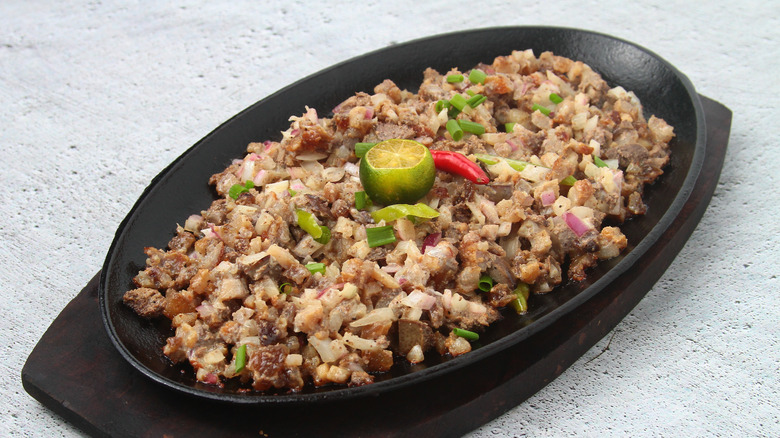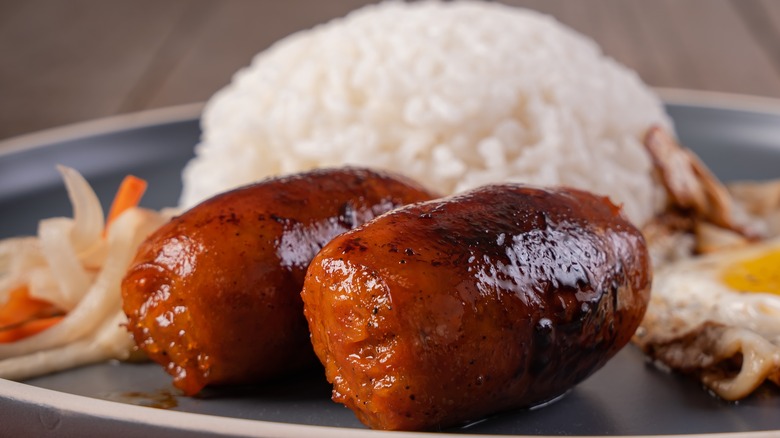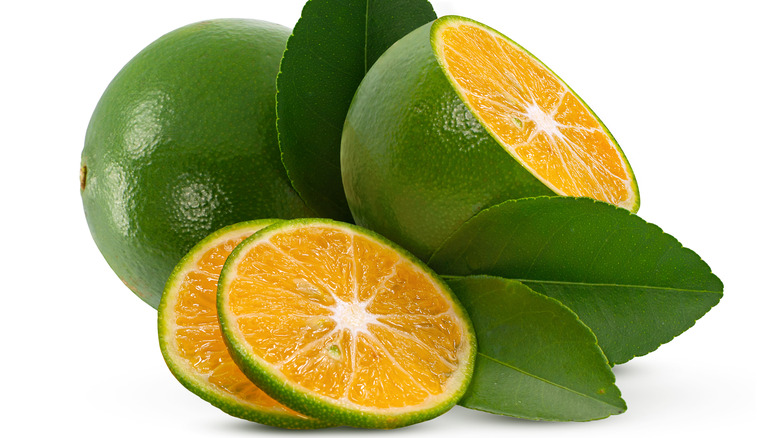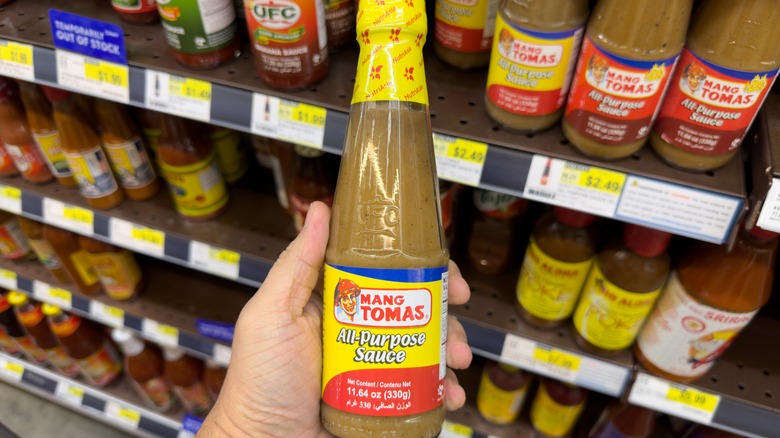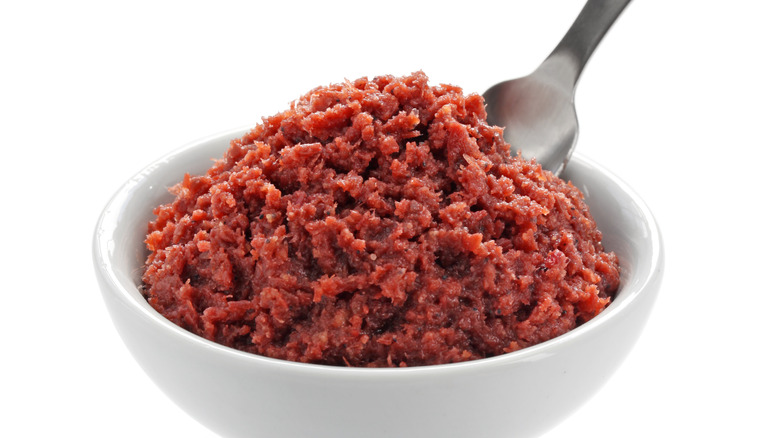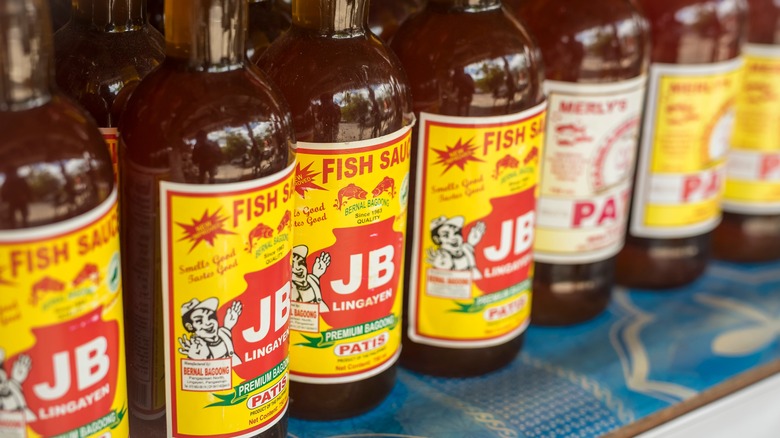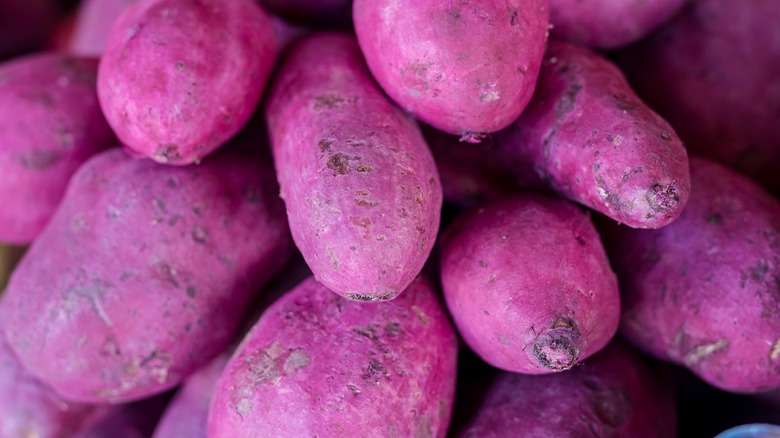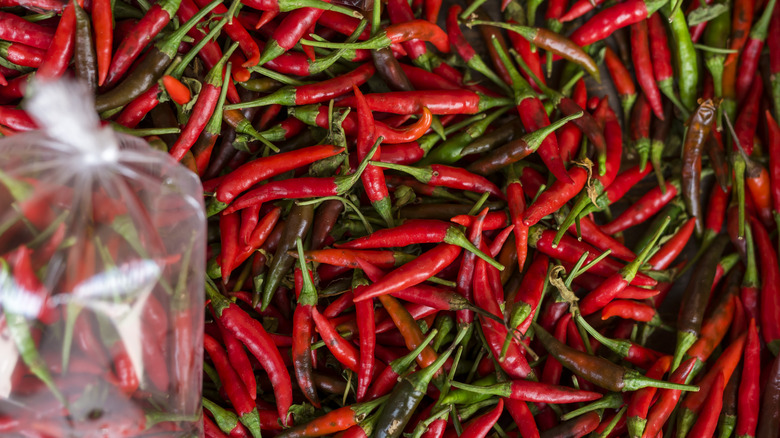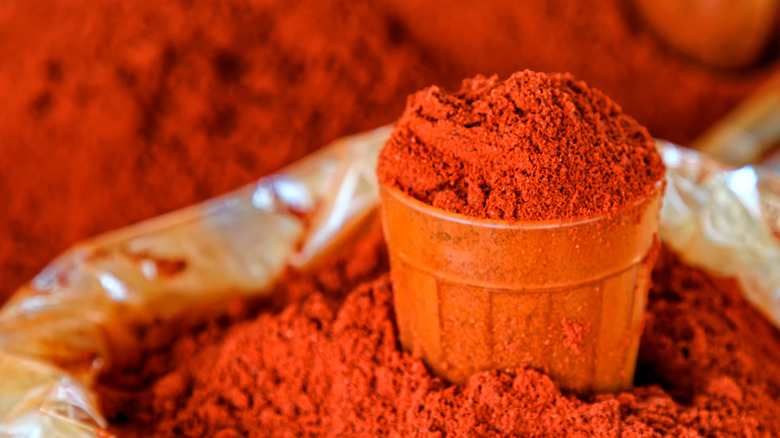13 Essential Filipino Ingredients, Explained
In recent years, Filipino cuisine has become a growing trend in the U.S. dining scene. You may have noticed Filipino restaurants popping up near you. The Filipino fast-food chain Jollibee continues to expand into the North American market with new locations. If you've developed a taste for Filipino flavors from eating in restaurants or consuming food media, you might be interested in trying to cook some classic dishes at home. However, playing around with a whole new cuisine as a home cook can be intimidating. It's hard to know when to start when you aren't even sure what ingredients you need to buy.
That's where this guide comes in. We're breaking down some of the most commonly used ingredients in Filipino households, with a special focus on foods that might not be stocked in an average American kitchen. You'll find out what these ingredients taste like, how to buy them (if they're available outside of the Phillippines), and what recipes they're used in. After reading this, you'll be ready to assemble a basic Filipino pantry and start cooking Pinoy dishes at home.
1. Tocino
Tocino is a type of marinated, cured meat that's typically eaten as part of a traditional Filipino breakfast. It can be made with beef or chicken, but the most common type is pork-based. Fatty cuts like shoulder are the classic choice. It can be thought of as the Filipino equivalent of ham or bacon; in fact, in Spanish, the word "tocino" means "bacon." If you live in the U.S., it's unlikely you'll be able to find pre-made tocino in a store unless you live near a Filipino market or a particularly well-stocked Asian grocery. Fortunately, it's fairly easy to find online.
Tocino marinades vary, but the main components are sugar and garlic. The meat is preserved with curing agents like Prague powder #1 (aka sodium nitrate) and vitamin C. It's usually dyed bright red with food coloring as well. If you'd like to try your hand at making it at home, it's fairly easy — you can even buy prepared tocino marinade mixes to simplify the process. Just be aware that home marinades may not always include preservatives, so homemade tocino is best eaten fresh.
To make the classic Filipino breakfast dish tocilog, fry up sliced tocino and serve it alongside a sunnyside-up egg and some garlic fried rice. The sweet-salty flavor of the tocino is the perfect partner for the savory garlic rice and the creamy egg.
2. Longanisa
If tocino is the Filipino answer to bacon, longanisa is the nation's version of breakfast sausage. Like tocino, longanisa is often fried alongside garlic rice and served for the first meal of the day. These little sausage links can be found either skinless or stuffed into casings. Either way, they're usually made with ground fatty pork. The seasoning mix is somewhat similar to tocino with a heavy emphasis on sugar and garlic — some recipes for homemade tocino call for over a head of garlic per pound of meat. Longanisa is also typically orange or red; this color can be achieved naturally by using paprika.
When shopping for longanisa, you can find sweet or spicy versions, as well as varieties made with beef or chicken instead of pork. Be careful not to confuse it with sausages from other countries that have similar names: Argentinian longaniza tends to have a strong anise seed flavor that you won't necessarily find in the Filipino version. It also isn't made with as much sugar.
3. Vinegar
Acidity plays a more prominent role in Filipino cuisine than it does in many other food traditions; as such, it makes sense that vinegar is an essential Filipino pantry staple. In addition to providing a sourness, vinegar can also increase the shelf life of food, an attribute traditionally prized in the Philippines, which has a hot climate that causes food to spoil quickly. Vinegar can be used as a condiment tableside, a seasoning for soups, or a cooking medium. Chicken adobo, perhaps the most famous Filipino dish stateside, is cooked in a broth made with vinegar and soy sauce.
In the Phillippines itself, there are countless different varieties of traditional regional vinegars. Shoppers in the U.S. shouldn't have too much trouble accessing the two most common ones: cane and coconut. Cane vinegar is the easiest to find. It's made from sugarcane juice and is sold in a neutral white variety or a dark version brewed using molasses. Coconut vinegar is harsher and more sour than cane vinegar.
Another typical Filipino vinegar, palm vinegar tends toward the milder, sweeter end of the spectrum. This one might be harder to locate in U.S. stores, but it is available online. The traditional version is bottled with living microorganisms — just like fancy apple cider vinegar — so its flavor changes as it continues to ferment inside the packaging.
4. Toyo
"Toyo" is the Tagalog word for soy sauce. While soy sauce didn't originate in the Philippines (it came from China) the version used in the Philippines has its own special flavor. Made with water, salt, soybeans, caramel color, and wheat, it has a thin texture and an extra salty taste compared to soy sauce from other countries.
The salt and umami of soy sauce are often used to balance out the acidity in Filipino recipes. This is what soy sauce does in adobo, and this is also its function in two popular condiments: toyomansi (soy sauce plus calamansi citrus juice) and toyo, suka, at sili (soy sauce plus vinegar, often seasoned with chiles and onion). It's also an essential flavor component for dishes like pansit (noodles with meat and vegetables) and sisig (stir-fried pork with chiles).
While you can get away with using whatever soy sauce you already have in your pantry to cook Filipino dishes, it's worth seeking out real toyo to make them taste as authentic as possible. Silver Swan brand is easy to find in the U.S., is one of the most popular choices in the Philippines, and has a history that stretches back to the 1940s.
5. Calamansi
Besides vinegar, calamansi is the other main source of acidity in Filipino cuisine. The fruit is also called by the names calamondin, Philippine lemon, and Philippine lime. The flavor of this citrus fruit is bright and acidic, somewhat similar to conventional limes and lemons. The peel is usually green, though in the rare instances when you can find fully ripe calamansi, the peel will be orange.
The entire fruit, including the peel and rind, is edible — like kumquats — and the calamansi peels are sweeter than the flesh of the fruit. Unripe green examples look like standard limes until you cut them open, which reveals their orange flesh. At around an inch wide, they're smaller than many other types of citrus. Often, calamansi is simply sliced into wedges and served at the table to squeeze on top of food as a finishing touch, similar to how limes are served with Mexican food. The juice can also be used as a component in condiments or as a meat marinade, as in the stewed beef dish bistek tagalog.
Fresh calamansi aren't widely available in the U.S., but lemons and limes make fine substitutes in a pinch. If you don't live near a store that sells the fruit fresh, it's pretty easy to find bottled calamansi extract or concentrated frozen calamansi juice online.
6. Banana ketchup
Banana ketchup was the product of local ingenuity in the Philippines. The U.S. invaded and annexed the country in the late 1800s, introducing the local inhabitants to tomato ketchup. The condiment became popular, but there was a problem: Tomatoes were hard to grow locally. In the 1930s, Filipina food scientist Maria Orosa (who later became renowned for her heroic work during World War II) came up with a way to make a ketchup-like condiment with local produce. Banana ketchup (aka banana sauce) was born.
While the idea of putting bananas in ketchup might seem odd at first, it really doesn't taste that different from tomato ketchup. The banana flavor isn't very strong. The Filipino sauce is a little sweeter and less tangy than tomato ketchup due to the natural sweetness of the bananas and the fact that it's made without vinegar. Banana sauce even looks like tomato ketchup because it's typically dyed red to camouflage its natural brown color.
In the Philippines, it's used for many of the same things that Americans use ketchup for: as a condiment for fried foods or an ingredient in barbecue marinades. It's also a common ingredient in Filipino spaghetti sauces, which may be more of an acquired taste — not everyone loves sweet ketchup spaghetti if they didn't grow up with it.
7. Mang Tomas All-Purpose Sauce
Mang Tomas All-Purpose Sauce is a bottled condiment that's descended from a recipe cooked up by Tomas Delos Reyes in the 1950s. Reyes started out as a butcher with a stall across the street from a popular cockfighting stadium. He realized that he could make extra money if he started selling roasted pork (lechon) to the crowds exiting the stadium, and his lechon business became a runaway success. There are still Mang Tomas restaurants to this day, but the brand is now most commonly associated with its famous sauce, which was originally formulated to accompany roast pork.
Like most Filipino lechon sauces, the classic recipe of Mang Tomas included ground liver, but the modern version no longer contains this ingredient. Instead, it's a thick, pasty mixture of water, vinegar, breadcrumbs, sugar, spices, and flavor enhancers. The sugar gives it a fairly sweet, barbecue sauce-like flavor. Mang Tomas is mild enough that, as its name suggests, it can pair with almost any type of food, though it probably tastes best with the roasted or fried meats it was originally intended to go with.
8. Shrimp paste
Filipino cooks employ a variety of different types of shrimp pastes, but all of them serve more or less the same function: to impart a distinct umami flavor to food. They all also start the same way: producers take shrimp (or krill, which is another type of small crustacean) and ferment it with salt until it becomes savory and aromatic. Shrimp paste is an integral ingredient in Filipino classics like Bicol Express (a spicy coconut milk-based pork stew) and fried rice. It's also used as a condiment for sliced raw mangos, which is a delightful salty-sweet combination.
When shopping for Filipino shrimp paste, it's helpful to know the names of the different types to make sure you're buying the right kind for your intended recipe. The raw type is known as bagoong alamang; it's usually light pink to reddish in color and sometimes includes visible pieces of shrimp. Sautéed shrimp paste, ginisang bagoong alamang, is made by frying the raw kind with oil (or pork fat) and aromatics like garlic, onion, and chiles. It can be bought pre-made, but different brands can have wildly varying levels of sweetness, acidity, and heat, so you might need to experiment to find the jar that works for you.
Along with these two basic types, there are also more regional iterations of shrimp paste. One that is worth noting is balaw-balaw (or balao-balao) from the Bicol area. It's darker and thicker than standard raw shrimp paste and has a stronger smell.
9. Fish sauce
The fish sauce used in the Philippines isn't dramatically different from the type used in Southeast Asian countries like Vietnam, but it's an important enough part of Filipino cuisine to warrant a place on this list. Like shrimp paste, fish sauce is made by salting seafood and letting it ferment — essentially, it's a controlled rotting process. The difference is that fish sauce is composed of the thin, translucent liquid created during the fermentation process. The chunks are then strained out. Often, fish sauce is fermented using small fish like anchovies, but shrimp may be used too. Sometimes, Filipino shrimp paste manufacturers bottle their leftover shrimp paste liquid and sell it as fish sauce.
The most common use of fish sauce in Filipino cuisine is as a flavor enhancer for broths, soups, and stews. Its unique bend of salt, umami, and sweetness adds depth and richness to any dish. It's also employed as a condiment, similar to soy sauce. Its high sodium content means it can act as a substitute for salt when seasoning meat, and it can be mixed with calamansi juice and chiles to make a spicy-sour dipping sauce.
10. Ube
Ube is a type of Filipino purple yam that tastes like a sweeter, vanilla-and-nut-inflected version of a standard orange sweet potato. Although it can be cooked in savory recipes, its high-sugar content makes Ube ideal for desserts. Ube's bright purple color makes for eye-catching confections, so there's a good chance you've stumbled across ube desserts on social media before. It's rare to come across fresh ube in U.S. stores. It's more likely that you'll find the tuber frozen and pre-cooked in the Asian grocery store. It's also sold in powdered and extract form.
In the Philippines, ube is used for a wide variety of confections. One classic use is in ube halaya. This treat is often translated as ube jam, but it's more like a custard, as it's made with a base of coconut milk, butter, and sugar. Another traditional ube dessert is ube ice cream, which is best enjoyed in the layered shaved ice dessert halo-halo. Halo-halo is super-customizable, but it usually incorporates ice, various types of fruit, ube ice cream, and condensed or evaporated milk, all stacked in eye-catching layers.
11. Siling labuyo
Filipino food has its fair share of spicy dishes. We've already mentioned spicy stews like Bicol Express and stir-fries like sinigang. There's also dinuguan, a spicy pork blood soup, and kinunot, a famously hot mixed seafood dish, to name just a couple more. And when Filipinos want to add burn to a dish, the traditional chile to reach for is siling labuyo. This tiny chile looks like a smaller version of a Thai birdseye and packs a serious punch, with a Scoville rating of up to 100,000, 40 times hotter than a jalapeño. In addition to the fruit, the leaves of the plant can also be used to flavor soups.
Although siling labuyo grows wild in the Philippines and is often cultivated by home gardeners in the country, its short shelf life makes it less than ideal for grocery stores. For this reason, supermarkets in the Philippines increasingly have started importing Thai chiles, sometimes even mislabeling them as true siling labuyo. The competition from Thai chiles is putting the future of siling labuyo as a commercial crop into question.
12. Achuete
Achuete is the Filipino name for achiote spice, otherwise known as annatto. You can probably find annatto seed powder in a regular American grocery store, but if you want the Filipino version, it's readily available from online retailers. The spice is used to add yellow-orange color to dishes like kare kare, which is a beef stew cooked in peanut butter–based gravy seasoned with fish sauce and achuete.
This spice has a much stronger color than flavor. Just a touch can dye a large batch of food, but its taste is elusive and hard to describe. Depending on who you ask, they may describe achuete as earthy, floral, peppery, nutty, or slightly sweet.
When you're stocking up on achuete, reach for powder instead of whole seeds. While whole spices are often more flavorful than pre-ground ones, with achuete, it just isn't worth it. The seeds are super-hard and won't break down fully in a mortar and pestle.
13. Malunggay
Malunggay is what Filipinos call the leaves of the moringa tree. These nutritious leaves can be eaten as a green vegetable. They're packed with beneficial compounds like potassium, vitamin C, calcium, and iron (via WebMD). Malunggay has a grassy, bitter flavor with a bit of kick that's reminiscent of horseradish — moringa is colloquially known as the horseradish tree. Like siling labuyo plants, moringa trees are a frequent feature of Filipino home gardens.
This ingredient shows up frequently in soupy recipes like dinengdeng, a medley of mixed vegetables cooked in broth that's topped with fried whole fish. It also shows up in chicken tinola, a hearty and warming chicken stew with fish sauce, ginger, garlic, and chayote squash.
Though the leaves are the most commonly eaten part of the moringa tree, the fruit, bungga ng malunggay, is edible as well. Like the leaves, it has a bitter flavor. You'll often find it in stir-fries paired with ingredients like tomato, garlic, lima beans, okra, and cabbage.
